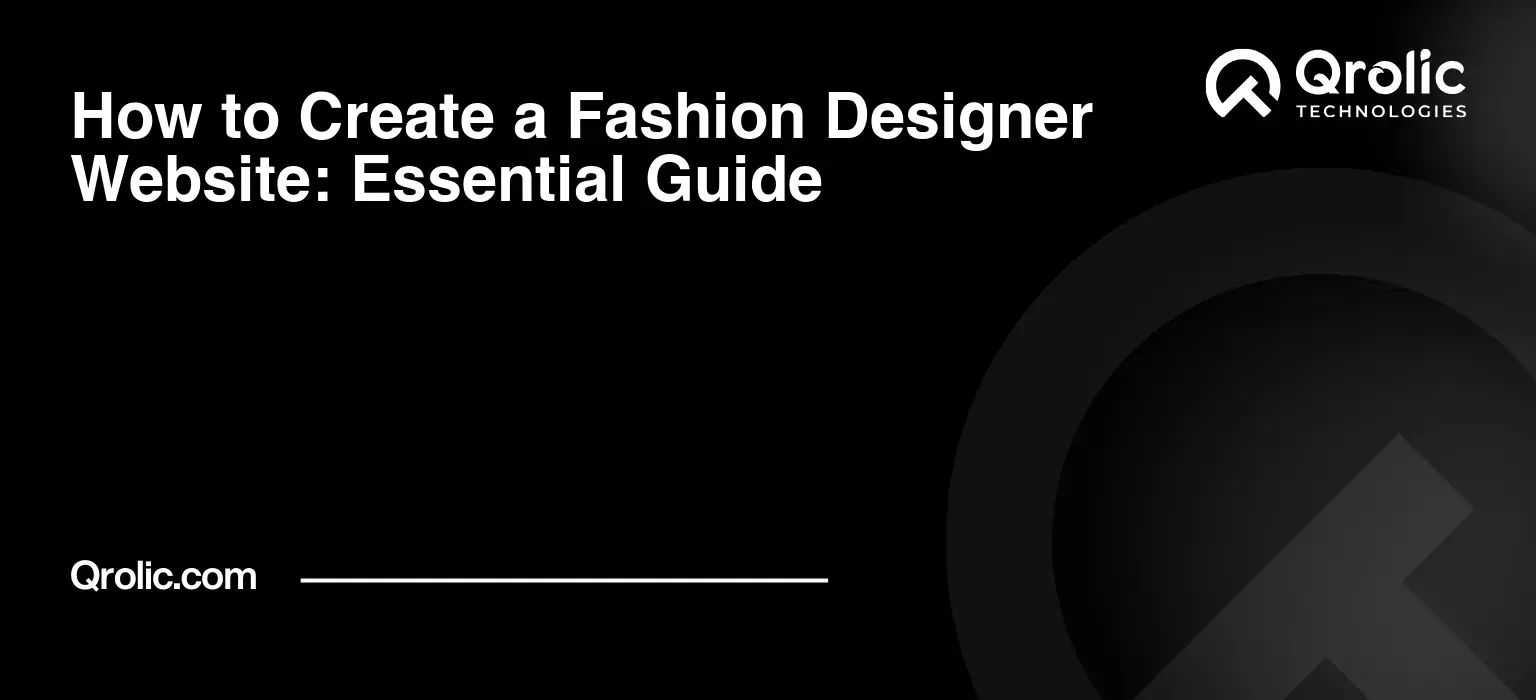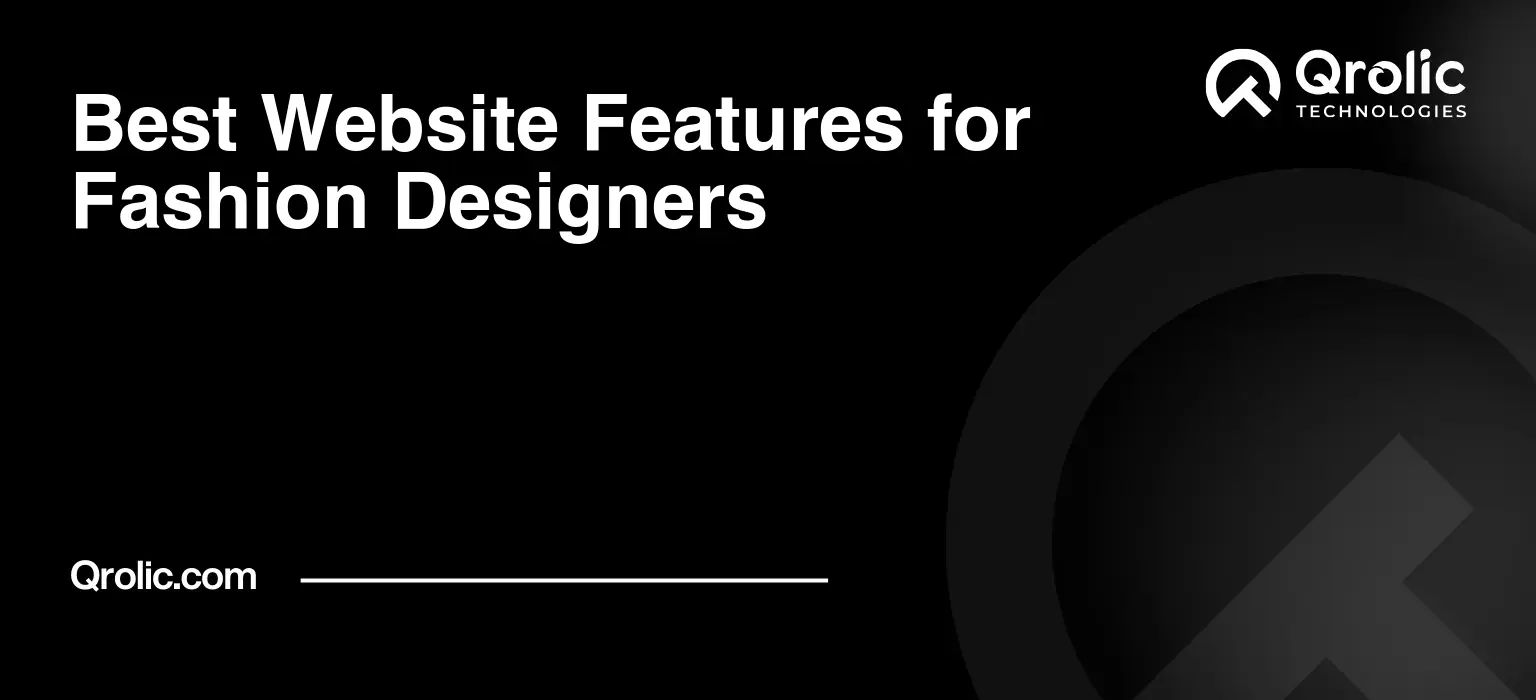Your fashion designs are the voice of your creativity. Your website is the megaphone. In today’s digital age, a stunning and functional website isn’t just an option; it’s the lifeblood of a successful fashion brand. This essential guide provides a comprehensive roadmap for creating a fashion designer website that not only showcases your work but also drives sales, builds your brand, and connects you with your audience.
Quick Summary:
- Your website is key to showcase designs and boost sales.
- Focus on stunning visuals, clear navigation, and e-commerce.
- Use SEO and engaging content to attract your audience.
- Ensure your site is mobile-friendly and legally compliant.
Table of Contents
- I. Why Your Fashion Brand NEEDS a Website
- 1. Establishing Online Presence and Brand Authority
- 2. Showcasing Your Designs and Collections
- 3. Driving Sales and E-commerce Capabilities
- 4. Building Your Email List and Customer Relationships
- 5. Strengthening SEO and Online Visibility
- II. Essential Elements of a Fashion Designer Website
- 1. Stunning Visual Design and Aesthetics
- 2. Compelling Product Pages
- 3. Engaging About Us Page
- 4. Easy Navigation and User Experience
- 5. Secure and Reliable E-commerce Platform
- III. Choosing the Right Platform: Website Builders vs. Custom Development
- 1. Website Builders: Simplicity and Affordability
- 2. Custom Development: Flexibility and Scalability
- IV. SEO Strategies for Fashion Designer Websites
- 1. Keyword Research: Identifying Your Target Audience’s Search Terms
- 2. On-Page Optimization: Optimizing Your Website’s Content and Structure
- 3. Off-Page Optimization: Building Authority and Reputation
- 4. Mobile Optimization: Ensuring a Mobile-Friendly Experience
- 5. Analytics and Tracking: Measuring Your SEO Performance
- V. Content Marketing Strategies for Fashion Designers
- 1. Blog Posts: Sharing Your Expertise and Inspiration
- 2. Lookbooks: Showcasing Your Collections in Style
- 3. Videos: Engaging Your Audience with Visual Content
- 4. Social Media Marketing: Reaching Your Target Audience on Social Platforms
- 5. Email Marketing: Nurturing Your Leads and Driving Sales
- VI. Essential E-commerce Functionality for Fashion Designer Websites
- 1. Product Catalog Management: Organizing Your Designs
- 2. Shopping Cart and Checkout: Making it Easy to Purchase
- 3. Shipping and Delivery: Providing a Seamless Experience
- 4. Customer Accounts: Building Relationships and Loyalty
- 5. Customer Service: Providing Support and Addressing Inquiries
- VII. Launching and Promoting Your Fashion Designer Website
- 1. Website Testing: Ensuring Functionality and User Experience
- 2. Search Engine Submission: Getting Indexed by Search Engines
- 3. Social Media Promotion: Spreading the Word
- 4. Email Marketing: Announcing Your Website to Your Subscribers
- 5. Paid Advertising: Reaching a Wider Audience
- VIII. Qrolic Technologies: Your Partner in Digital Success
- IX. Staying Updated with Fashion Website Trends
- 1. Mobile-First Design
- 2. Personalized Shopping Experiences
- 3. Visual Search
- 4. Augmented Reality (AR) and Virtual Reality (VR)
- 5. Sustainable and Ethical Practices
- X. Legal Considerations for Fashion Designer Websites
- 1. Copyright and Trademark Protection
- 2. Privacy Policy
- 3. Terms and Conditions
- 4. E-commerce Regulations
- 5. Accessibility Laws
I. Why Your Fashion Brand NEEDS a Website
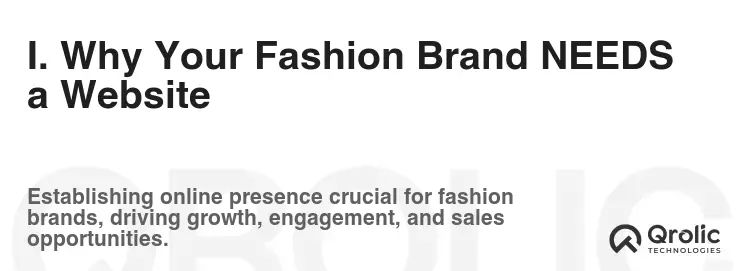
1. Establishing Online Presence and Brand Authority
In the competitive fashion industry, a website is your digital storefront, open 24/7. It’s where potential customers form their first impression of your brand.
- First Impressions Matter: A professionally designed website immediately establishes credibility and showcases the quality of your work.
- Brand Storytelling: Your website allows you to tell your brand’s story, share your inspiration, and connect with customers on an emotional level.
- Control Your Narrative: Unlike social media platforms, you have complete control over the content and design of your website, allowing you to curate a consistent brand image.
2. Showcasing Your Designs and Collections
Your website is the ultimate portfolio for displaying your latest creations.
- High-Quality Imagery: Showcase your designs with professional, high-resolution photos and videos.
- Detailed Product Descriptions: Provide comprehensive details about each piece, including materials, sizing, care instructions, and styling tips.
- Lookbooks and Collections: Present your designs in curated collections or lookbooks to inspire customers and highlight your brand’s aesthetic.
- Behind-the-Scenes Content: Offer glimpses into your design process, studio, or inspiration to add a personal touch and connect with your audience.
3. Driving Sales and E-commerce Capabilities
A website provides a direct-to-consumer platform, allowing you to sell your designs without relying on third-party retailers.
- E-commerce Integration: Seamlessly integrate e-commerce functionality to allow customers to browse, select, and purchase your designs directly from your website.
- Secure Payment Gateways: Offer secure and reliable payment options to build trust and ensure a smooth purchasing experience.
- Inventory Management: Implement an inventory management system to track stock levels and prevent overselling.
- Shipping and Delivery: Clearly outline your shipping policies, delivery options, and return policies.
4. Building Your Email List and Customer Relationships
A website allows you to capture customer information and build valuable relationships.
- Email Opt-in Forms: Encourage visitors to subscribe to your email list to receive updates on new collections, promotions, and exclusive content.
- Customer Accounts: Allow customers to create accounts to save their information, track orders, and receive personalized recommendations.
- Customer Service: Provide a contact form or live chat feature to address customer inquiries and provide support.
- Feedback and Reviews: Encourage customers to leave reviews and provide feedback to improve your products and services.
5. Strengthening SEO and Online Visibility
A well-optimized website can significantly improve your search engine rankings and drive organic traffic.
- Keyword Research: Identify relevant keywords that your target audience is searching for. (e.g., “sustainable fashion,” “custom-made dresses,” “designer clothing online”)
- On-Page Optimization: Optimize your website’s content, titles, and meta descriptions with relevant keywords.
- Mobile-Friendliness: Ensure your website is responsive and optimized for mobile devices.
- Link Building: Build high-quality backlinks from reputable websites to increase your website’s authority.
- Content Marketing: Create valuable content, such as blog posts, articles, and videos, to attract and engage your target audience.
II. Essential Elements of a Fashion Designer Website
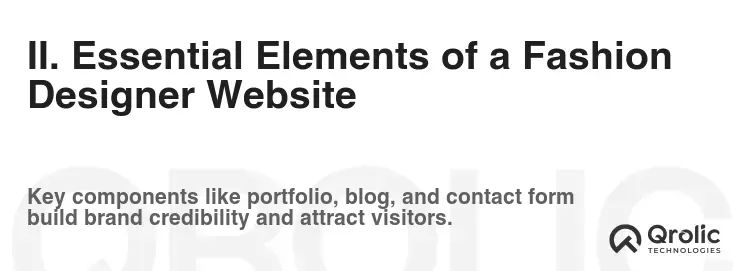
1. Stunning Visual Design and Aesthetics
Your website’s design should reflect your brand’s aesthetic and appeal to your target audience.
- Clean and Minimalist Design: Embrace simplicity and avoid clutter to showcase your designs effectively.
- High-Quality Photography: Invest in professional photography that captures the details and essence of your designs.
- Consistent Branding: Use your brand’s logo, colors, and typography consistently throughout your website.
- Intuitive Navigation: Ensure your website is easy to navigate and that visitors can quickly find what they are looking for.
- Mobile Responsiveness: Your website must be fully responsive and optimized for all devices, including smartphones and tablets.
2. Compelling Product Pages
Your product pages are where you convert visitors into customers.
- High-Resolution Images: Use multiple high-resolution images from different angles to showcase each product.
- Detailed Product Descriptions: Provide comprehensive details about the materials, sizing, care instructions, and styling tips.
- Size Charts: Include accurate size charts to help customers choose the right fit.
- Customer Reviews: Display customer reviews and testimonials to build trust and credibility.
- “Add to Cart” and “Checkout” Buttons: Make it easy for customers to add products to their cart and proceed to checkout.
3. Engaging About Us Page
Your “About Us” page is an opportunity to connect with your audience on a personal level and share your brand’s story.
- Brand Story: Share the story of your brand’s creation, your inspiration, and your mission.
- Designer Bio: Introduce yourself and your team, and share your background and experience.
- Brand Values: Highlight your brand’s values, such as sustainability, ethical production, or craftsmanship.
- Behind-the-Scenes Content: Offer glimpses into your design process, studio, or inspiration to add a personal touch.
- Contact Information: Provide clear contact information and encourage visitors to reach out with questions or inquiries.
4. Easy Navigation and User Experience
A user-friendly website is essential for keeping visitors engaged and encouraging them to explore your designs.
- Clear Menu Structure: Use a clear and intuitive menu structure to help visitors navigate your website.
- Search Functionality: Implement a search function to allow visitors to quickly find specific products or information.
- Breadcrumbs: Use breadcrumbs to help visitors understand their location within the website.
- Fast Loading Speed: Optimize your website for fast loading speed to prevent visitors from leaving.
- Accessibility: Ensure your website is accessible to users with disabilities by following accessibility guidelines.
5. Secure and Reliable E-commerce Platform
If you plan to sell your designs online, you need a secure and reliable e-commerce platform.
- Secure Payment Gateways: Integrate with reputable payment gateways, such as PayPal, Stripe, or Authorize.net, to ensure secure transactions.
- SSL Certificate: Install an SSL certificate to encrypt data and protect customer information.
- Fraud Prevention: Implement fraud prevention measures to protect your business from fraudulent transactions.
- Order Management System: Use an order management system to track orders, manage inventory, and process refunds.
- Shipping Integration: Integrate with shipping carriers, such as FedEx, UPS, or USPS, to automate shipping calculations and tracking.
III. Choosing the Right Platform: Website Builders vs. Custom Development
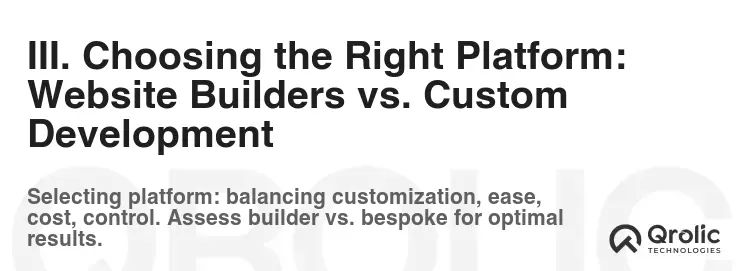
Selecting the right platform is a crucial decision that will impact your website’s functionality, design flexibility, and long-term scalability. There are two primary options: website builders and custom development.
1. Website Builders: Simplicity and Affordability
Website builders, such as Shopify, Squarespace, and Wix, offer user-friendly interfaces and pre-designed templates, making them ideal for designers with limited technical skills.
- Pros:
- Easy to Use: Drag-and-drop interfaces and pre-designed templates make it easy to create a website without coding knowledge.
- Affordable: Website builders offer various pricing plans to fit different budgets.
- All-in-One Solution: Website builders typically include hosting, security, and e-commerce functionality.
- App Ecosystem: Many website builders offer app stores with plugins and integrations to extend functionality.
- Cons:
- Limited Customization: Website builders offer limited customization options compared to custom development.
- Platform Dependency: You are locked into the website builder’s platform and may have difficulty migrating your website to another platform in the future.
- Transaction Fees: Some website builders charge transaction fees on sales.
Examples of Popular Website Builders for Fashion Designers:
- Shopify: A dedicated e-commerce platform with powerful features for selling fashion designs online. Offers extensive customization options and a robust app ecosystem.
- Squarespace: Known for its beautiful templates and user-friendly interface. Suitable for designers who want a visually appealing and easy-to-manage website.
- Wix: Offers a wide range of templates and customization options. Suitable for designers who want a flexible and affordable website builder.
2. Custom Development: Flexibility and Scalability
Custom development involves hiring a web developer or agency to build a website from scratch, providing complete control over design and functionality.
- Pros:
- Complete Customization: You have complete control over the design and functionality of your website.
- Scalability: Custom-built websites can be easily scaled to accommodate future growth.
- Unique Design: You can create a website that is completely unique and reflects your brand’s identity.
- Performance: Custom-built websites can be optimized for performance and speed.
- Cons:
- Expensive: Custom development is significantly more expensive than using a website builder.
- Time-Consuming: Custom development can take several weeks or months to complete.
- Technical Expertise Required: You need technical expertise to maintain and update a custom-built website.
When to Choose Custom Development:
- You have complex requirements that cannot be met by a website builder.
- You want complete control over the design and functionality of your website.
- You need a website that is highly scalable and optimized for performance.
- You have a large budget and are willing to invest in a custom solution.
Which Option is Right for You?
The best option depends on your budget, technical skills, and specific requirements. If you are on a tight budget and need a simple website quickly, a website builder is a good option. If you have complex requirements and want complete control over your website, custom development is a better choice.
IV. SEO Strategies for Fashion Designer Websites
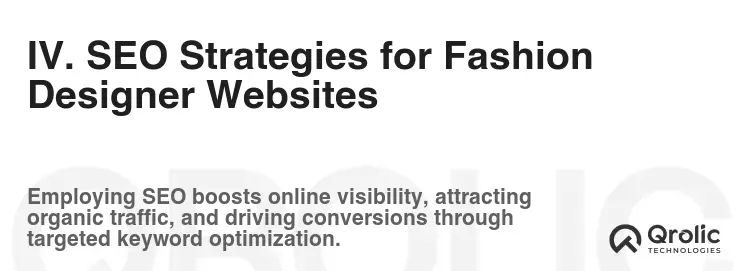
Search engine optimization (SEO) is crucial for driving organic traffic to your website and increasing your online visibility.
1. Keyword Research: Identifying Your Target Audience’s Search Terms
Keyword research involves identifying the words and phrases that your target audience is searching for when looking for fashion designs.
- Brainstorming: Start by brainstorming a list of keywords related to your brand, designs, and target audience. Consider terms like “sustainable fashion,” “custom-made dresses,” “designer clothing online,” “bohemian style,” or “luxury handbags.”
- Keyword Research Tools: Use keyword research tools, such as Google Keyword Planner, SEMrush, or Ahrefs, to identify high-volume, low-competition keywords.
- Competitor Analysis: Analyze your competitors’ websites to identify the keywords they are targeting.
- Long-Tail Keywords: Focus on long-tail keywords, which are longer and more specific phrases that can attract highly qualified traffic. For example, “sustainable organic cotton t-shirts for women” is a long-tail keyword.
2. On-Page Optimization: Optimizing Your Website’s Content and Structure
On-page optimization involves optimizing your website’s content and structure to improve its search engine rankings.
- Title Tags: Optimize your title tags with relevant keywords. The title tag is the most important on-page SEO element.
- Meta Descriptions: Write compelling meta descriptions that accurately describe your website’s content and encourage users to click through from the search results.
- Header Tags: Use header tags (H1, H2, H3, etc.) to structure your content and highlight important keywords.
- Image Alt Text: Add alt text to your images to describe the image content to search engines.
- Internal Linking: Link to other relevant pages on your website to improve navigation and distribute link juice.
- Content Optimization: Create high-quality, informative, and engaging content that is optimized for your target keywords.
3. Off-Page Optimization: Building Authority and Reputation
Off-page optimization involves building your website’s authority and reputation through link building and social media marketing.
- Link Building: Acquire high-quality backlinks from reputable websites in your industry. This can be achieved through guest blogging, directory submissions, and broken link building.
- Social Media Marketing: Promote your website and designs on social media platforms to increase brand awareness and drive traffic.
- Influencer Marketing: Partner with fashion influencers to promote your brand and reach a wider audience.
- Online PR: Get your brand featured in online publications and blogs to increase brand awareness and build credibility.
4. Mobile Optimization: Ensuring a Mobile-Friendly Experience
Mobile optimization is crucial for ranking well in search results and providing a positive user experience for mobile users.
- Responsive Design: Ensure your website is responsive and adapts to different screen sizes.
- Mobile-Friendly Content: Optimize your content for mobile devices, using shorter paragraphs and larger fonts.
- Fast Loading Speed: Optimize your website for fast loading speed on mobile devices.
- Touch-Friendly Navigation: Ensure your website is easy to navigate on touchscreens.
5. Analytics and Tracking: Measuring Your SEO Performance
Analytics and tracking are essential for measuring your SEO performance and identifying areas for improvement.
- Google Analytics: Install Google Analytics to track your website’s traffic, user behavior, and conversions.
- Google Search Console: Use Google Search Console to monitor your website’s search performance and identify any technical issues.
- Keyword Tracking: Track your website’s ranking for your target keywords.
- Conversion Tracking: Track your website’s conversions, such as sales, leads, and email sign-ups.
V. Content Marketing Strategies for Fashion Designers
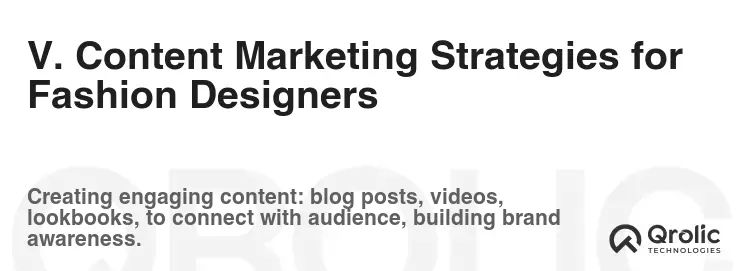
Content marketing is a powerful way to attract, engage, and convert your target audience by creating valuable and relevant content.
1. Blog Posts: Sharing Your Expertise and Inspiration
Blog posts are a great way to share your expertise, inspiration, and brand story.
- Behind-the-Scenes Content: Share glimpses into your design process, studio, or inspiration.
- Styling Tips: Provide styling tips and advice on how to wear your designs.
- Fashion Trends: Discuss current fashion trends and how your designs fit into the landscape.
- Designer Interviews: Interview other designers or fashion industry experts.
- Customer Stories: Share stories from your customers about how your designs have impacted their lives.
2. Lookbooks: Showcasing Your Collections in Style
Lookbooks are a visual way to showcase your collections and inspire customers.
- Professional Photography: Use high-quality photography to showcase your designs in a visually appealing way.
- Storytelling: Create a narrative around your lookbook to engage viewers and convey your brand’s message.
- Styling: Style your designs in different ways to show their versatility.
- Interactive Elements: Add interactive elements, such as links to product pages, to make it easy for viewers to purchase your designs.
3. Videos: Engaging Your Audience with Visual Content
Videos are a highly engaging form of content that can be used to showcase your designs, tell your brand story, and connect with your audience.
- Runway Shows: Share videos of your runway shows to give viewers a taste of your brand’s aesthetic.
- Behind-the-Scenes Videos: Share behind-the-scenes videos of your design process, studio, or photoshoots.
- Styling Tutorials: Create styling tutorials to show viewers how to wear your designs.
- Designer Interviews: Interview yourself or other designers about your inspiration and creative process.
4. Social Media Marketing: Reaching Your Target Audience on Social Platforms
Social media marketing is a crucial part of any content marketing strategy.
- Platform Selection: Choose the social media platforms that are most relevant to your target audience.
- Consistent Branding: Maintain a consistent brand identity across all social media platforms.
- Engaging Content: Create engaging content that is tailored to each platform.
- Community Building: Build a community around your brand by engaging with your followers and responding to their comments and questions.
5. Email Marketing: Nurturing Your Leads and Driving Sales
Email marketing is a powerful way to nurture your leads and drive sales.
- Email Opt-in Forms: Encourage visitors to subscribe to your email list by offering a freebie, such as a discount code or a style guide.
- Welcome Emails: Send a welcome email to new subscribers introducing your brand and sharing your story.
- Promotional Emails: Send promotional emails announcing new collections, sales, and events.
- Personalized Emails: Personalize your emails based on your subscribers’ interests and purchase history.
VI. Essential E-commerce Functionality for Fashion Designer Websites
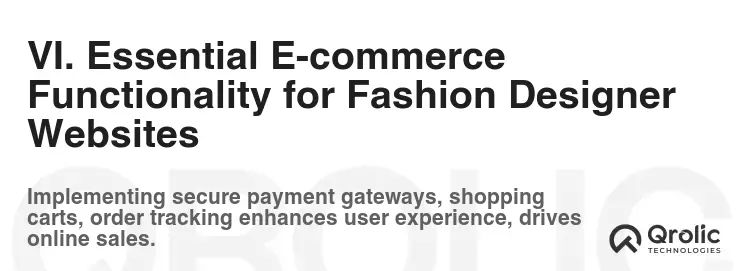
If you plan to sell your designs online, you need to implement essential e-commerce functionality to ensure a smooth and secure shopping experience for your customers.
1. Product Catalog Management: Organizing Your Designs
- Product Categories: Organize your designs into logical categories to make it easy for customers to find what they are looking for.
- Product Attributes: Add product attributes, such as size, color, and material, to help customers filter and sort your designs.
- Inventory Management: Implement an inventory management system to track stock levels and prevent overselling.
- Product Variations: Offer product variations, such as different sizes or colors, on a single product page.
2. Shopping Cart and Checkout: Making it Easy to Purchase
- Easy to Add to Cart: Make it easy for customers to add products to their cart with a clear “Add to Cart” button.
- Shopping Cart Visibility: Make the shopping cart visible on every page of your website.
- Secure Checkout Process: Ensure a secure checkout process with SSL encryption and reputable payment gateways.
- Multiple Payment Options: Offer multiple payment options, such as credit cards, PayPal, and Apple Pay.
- Guest Checkout: Allow customers to checkout as guests without creating an account.
3. Shipping and Delivery: Providing a Seamless Experience
- Shipping Options: Offer a variety of shipping options, such as standard, expedited, and international shipping.
- Shipping Rates: Calculate shipping rates accurately based on the customer’s location and the weight and dimensions of the package.
- Order Tracking: Provide order tracking information to customers so they can track their packages.
- Clear Shipping Policies: Clearly outline your shipping policies, including delivery times and return policies.
4. Customer Accounts: Building Relationships and Loyalty
- Account Creation: Allow customers to create accounts to save their information, track orders, and receive personalized recommendations.
- Order History: Allow customers to view their order history and track the status of their orders.
- Saved Addresses: Allow customers to save multiple shipping addresses.
- Wish Lists: Allow customers to create wish lists of their favorite designs.
5. Customer Service: Providing Support and Addressing Inquiries
- Contact Form: Provide a contact form on your website for customers to submit inquiries.
- FAQ Page: Create an FAQ page to answer common customer questions.
- Live Chat: Implement a live chat feature to provide real-time support to customers.
- Email Support: Respond to customer inquiries via email in a timely manner.
VII. Launching and Promoting Your Fashion Designer Website
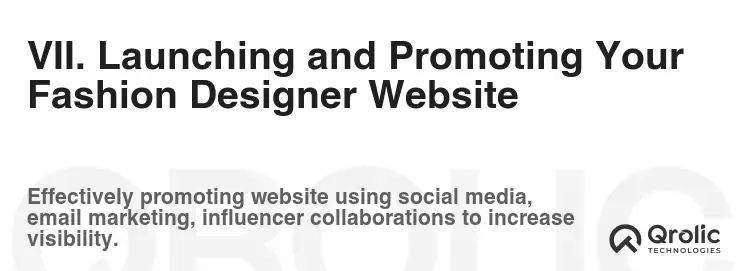
Once you have created your website, it’s time to launch it and start promoting it to your target audience.
1. Website Testing: Ensuring Functionality and User Experience
- Cross-Browser Testing: Test your website on different browsers, such as Chrome, Firefox, and Safari, to ensure it displays correctly.
- Mobile Testing: Test your website on different mobile devices to ensure it is responsive and user-friendly.
- Functionality Testing: Test all of the functionality on your website, such as the shopping cart, checkout process, and contact form.
- User Testing: Ask friends, family, or colleagues to test your website and provide feedback.
2. Search Engine Submission: Getting Indexed by Search Engines
- Submit Your Sitemap: Submit your website’s sitemap to Google Search Console to help Google crawl and index your website.
- Claim Your Google My Business Listing: Claim your Google My Business listing to improve your local search visibility.
- Build Backlinks: Build high-quality backlinks from reputable websites to increase your website’s authority.
3. Social Media Promotion: Spreading the Word
- Announce Your Launch: Announce the launch of your website on social media platforms.
- Run Contests and Giveaways: Run contests and giveaways to generate excitement and drive traffic to your website.
- Engage with Your Followers: Engage with your followers by responding to their comments and questions.
4. Email Marketing: Announcing Your Website to Your Subscribers
- Send a Launch Announcement: Send a launch announcement to your email subscribers.
- Offer a Discount Code: Offer a discount code to new subscribers to incentivize them to purchase your designs.
- Highlight Your New Designs: Highlight your new designs in your launch email.
5. Paid Advertising: Reaching a Wider Audience
- Google Ads: Run Google Ads campaigns to target customers who are searching for fashion designs online.
- Social Media Ads: Run social media ads to target customers based on their demographics, interests, and behaviors.
- Influencer Marketing: Partner with fashion influencers to promote your website and designs.
VIII. Qrolic Technologies: Your Partner in Digital Success

At Qrolic Technologies (https://qrolic.com/), we understand the unique needs of fashion designers in the digital landscape. We offer a comprehensive suite of services to help you create a stunning and effective website that showcases your talent and drives business growth.
- Website Design and Development: Our expert team can design and develop a custom website that reflects your brand’s aesthetic and meets your specific requirements. Whether you prefer a website builder platform or a fully custom solution, we have the expertise to bring your vision to life.
- E-commerce Solutions: We provide seamless e-commerce integration, secure payment gateways, and inventory management systems to help you sell your designs online with ease.
- SEO Services: Our SEO experts can help you improve your website’s search engine rankings and drive organic traffic. We offer keyword research, on-page optimization, off-page optimization, and content marketing services.
- Digital Marketing: We offer a range of digital marketing services, including social media marketing, email marketing, and paid advertising, to help you reach your target audience and promote your brand.
- Website Maintenance and Support: We provide ongoing website maintenance and support to ensure your website is always up-to-date, secure, and performing at its best.
Partner with Qrolic Technologies and let us help you build a fashion designer website that is as unique and inspiring as your designs.
IX. Staying Updated with Fashion Website Trends
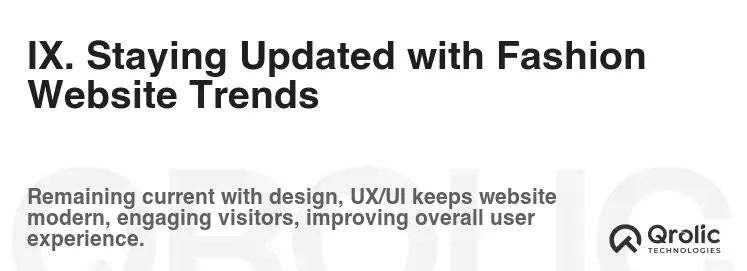
The digital landscape evolves rapidly, and it’s essential to stay updated with the latest trends in fashion website design and functionality.
1. Mobile-First Design
With the increasing use of mobile devices, it’s crucial to prioritize mobile-first design. This means designing your website for mobile devices first and then adapting it for desktop screens.
2. Personalized Shopping Experiences
Personalization is becoming increasingly important in e-commerce. Use data to personalize the shopping experience for each customer, such as recommending products based on their past purchases or browsing history.
3. Visual Search
Visual search allows customers to search for products using images. This can be particularly useful for fashion designers, as customers can easily find similar designs by uploading a picture of something they like.
4. Augmented Reality (AR) and Virtual Reality (VR)
AR and VR technologies are transforming the fashion industry. AR allows customers to virtually try on clothes or accessories, while VR allows customers to experience virtual fashion shows and events.
5. Sustainable and Ethical Practices
Consumers are increasingly concerned about sustainability and ethical practices. Highlight your brand’s commitment to sustainability and ethical production on your website.
X. Legal Considerations for Fashion Designer Websites
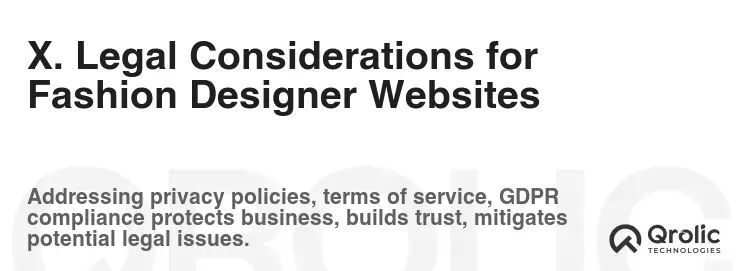
When creating a fashion designer website, it’s important to be aware of legal considerations to protect your brand and avoid potential legal issues.
1. Copyright and Trademark Protection
- Copyright: Protect your original designs and content by registering them with the appropriate copyright office.
- Trademark: Trademark your brand name and logo to prevent others from using them.
2. Privacy Policy
- Privacy Policy: Create a privacy policy that outlines how you collect, use, and protect customer data.
3. Terms and Conditions
- Terms and Conditions: Create terms and conditions that outline the rules and regulations for using your website.
4. E-commerce Regulations
- E-commerce Regulations: Comply with all applicable e-commerce regulations, such as consumer protection laws and data privacy laws.
5. Accessibility Laws
- Accessibility Laws: Ensure your website is accessible to users with disabilities by complying with accessibility laws, such as the Americans with Disabilities Act (ADA).
By following this essential guide, you can create a fashion designer website that showcases your talent, drives sales, and builds your brand. Remember to prioritize user experience, SEO, and content marketing to attract and engage your target audience. And don’t forget to partner with Qrolic Technologies for expert website design, development, and digital marketing services. With the right approach, your website can become the cornerstone of your fashion brand’s success.
